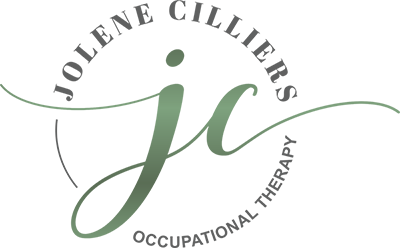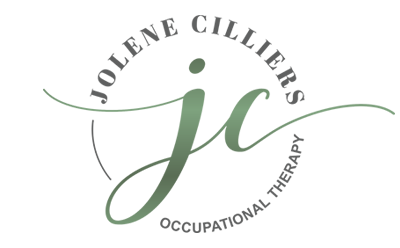Paediatric Services
Transforming Lives, Building Independence
Transforming Lives, Building Independence
Onsite or School Based intervention for children aged between birth to 12 years
Paediatric Occupational Therapy not only promotes development but encourages the achievement of success thus improving a child’s confidence, self-esteem, social participation and general well-being.
Jolene Cilliers Occupational Therapy provides practice and school-based services for children aged 0-12 years old.
This means that children are seen in their natural environment and skills gained in therapy can more easily be generalised to their everyday tasks and routines.
The assessment and therapy process is tailored to meet each child/family’s needs.
Who can benefit from Occupational Therapy?
Children presenting with difficulties in the following areas can benefit from OT:
Milestone and early childhood development (0-3 years)
Sensory integration
Physical impairment
Gross motor skills
Fine motor skills
Visual perceptual skills
Concentration and attention (ADD/ADHD)
School readiness
Learning difficulties at school; writing, reading, spelling, transcription and maths/mathematics
Paediatric OT’s help with:
- Prevention of difficulties (by providing information and education to parents, for example, on developmental norms and age-appropriate expectations)
- Health promotion (informing and encouraging parents to practise ways of promoting a child’s physical and mental wellbeing, based on our knowledge of evidence and real life experiences)
- Remediation activities and exercises for children (working directly with a child on their occupations using top down and bottom up approaches)
- Modifications to occupations (changing the amount of work expected if a child has poor handwriting speed)
- Modifications to the environment (for example by optimising the temperature and lighting if a child has trouble sleeping)
- Modifications of tools or equipment for activities of daily living, for example (using a built-up handle to help a child better grasp a spoon) ⠀ ⠀
And this doesn’t cover it all! As you can see, paediatric OTs don’t just work on physical skills and our job involves a lot more than working with children in X-minute sessions per week.
If only we could create change in such short periods! Outside of our direct work with children, we spend sessions educating, up-skilling and listening to parents/caregivers and teachers.
We also spend time learning from parents/caregivers; researching, collating and sharing evidence and information; finding new and creative ways for children to achieve their goals; evaluating progress and findings; and where possible, trying to prevent children from needing OT altogether.
It’s a huge job that’s often misunderstood!

Formal Assessment
An individualised 2-hour standardised assessment is conducted at the practice. A client centred and holistic approach to therapy is taken, meaning goals will be formulated and prioritised in collaboration with the family. A written report will provided, with findings and recommendations.

School Screening
We provide short screening for children aged 3-7 years, in order to determine whether occupational therapy is needed. This can be organised through the school, and entails age appropriate screenings of children identified to be struggling by their teachers.

Individual Therapy
Individual therapy is performed once a week at the practice or at the school. Regular therapy ensures that intervention is embedded, which, in turn, optimises the opportunities for social, emotional and physical growth. Written feedback on your child’s progress as well as home work is provided at the end of each session.

Home programmes
Sometimes a child does not need ongoing individual therapy, however you may still like suggestions for activities you can practice at home that would help alleviate their difficulties. We can organise a once-off parent only or parent/child sessions to cater for this, with formal home programmes offered if desired.

Professional Development for Schools
We are keen to work with teachers to ensure an integrated approach to children’s development. Professional Development sessions for teachers are offered, covering a range of topics. Sessions provide information, classroom strategies and resources to help all children.
Common Concerns
At Jolene Cilliers Occupational Therapy, we understand that all children are unique. We offer understanding, support, and effective intervention to children with a range of difficulties, including but not limited to the following:

Common Concerns
At Jolene Cilliers Occupational Therapy, we understand that all children are unique. We offer understanding, support, and effective intervention to children with a range of difficulties, including but not limited to the following:

Gross motor skills
Using whole body movements to achieve tasks such as running, jumping, hopping, climbing and skipping.

Handwriting
Including difficulties with letter formations, placement on lines/dotted thirds, spacing and sizing of writing.

Fine motor skills
Coordinating the hands and fingers to achieve tasks such as manipulating small items, holding a spoon, fastening buttons, holding a pencil, writing and cutting.

Muscle strength
Including strength in the core muscles, which affect gross motor skills and the ability to sit still/upright; upper body strength; and hand strength, which can contribute to difficulties with holding a pencil and handwriting.

Visual perceptual skills
Making sense of what is seen, for example, discriminating between different or similar shapes and forms, which is important for tasks such as reading, writing, completing puzzles, cutting, drawing and math problems.

Sensory processing
Integrating information received through the senses in a meaningful way, which may be exhibited through attention, behaviour, movement, arousal, anxiety and/or sensitivity to everyday input.

Regulation skills
Ability to maintain a functional level of alertness in order to respond appropriately to any given environment, including attention and emotions.

Executive functioning
Includes task initiation, impulse control, working memory, flexibility, planning, organisation, time management, goal-directed persistence and metacognition skills

Self-care skills
Coordinating the hands and fingers to achieve tasks such as manipulating small items, holding a spoon, fastening buttons, holding a pencil, writing and cutting.
Transforming Lives, Building Independence
Quick screening checklist
The following list was compiled to provide a quick overview of age appropriate development; this is not a comprehensive list and should not be taken as an absolute. Please contact us immediately if you have concerns.
0-2 Years Old
- Does not enjoy self-care activities e.g. bath time, dressing, cutting hair, brushing teeth.
- Picky eater e.g. prefers certain food, doesn’t like different textures / temperatures.
- Does not enjoy movement e.g. swinging /tilting head backwards.
- Does not enjoy sensory play e.g. getting hands dirty / playing with water / sitting on grass.
- Only prefers certain clothes, dislike shoes, walks on toes, does not like to be cuddled.
- Slow gross motor development (reached milestones late) e.g. rolling, sitting, crawling.
3 Year Olds
Gross motor:
- Can stand on toes
- Jump forward with 2 legs simultaneously
- Can catch a ball against body
- Can kick a ball without losing balance
- Endurance
- Good sitting and standing posture
Fine motor:
- Can open and close a bottle
- Attempts to colour a picture
- Can control a pair of scissors
- Can thread big beads
Concepts:
- Can identify 6-8 body parts
- Knows some of his/her body functions e.g. I listen with my ears
- Can match basic colours and some shapes
- Names at least 3 colours
- Can differentiate between big and small / short and tall
Visual Perceptual:
- Can match items or toys that looks the same
- Can find objects against a competing background
- Build a 6-12 piece puzzle
- Remember 2 items (Visual memory)
- Is able to follow simple instructions
Sensory:
- Enjoys movement and playing on apparatus (does not avoid swings for example)
- Eats different foods (textures/ hot / cold)
- Not a picky eater
- Enjoys self-care activities e.g. bathing, washing hair, brushing teeth
- Not bothered by daily noises
- Not bothered by light or dark
4 Year Olds
Gross motor:
- Can stand on one leg for 7-9 seconds
- Can catch a 20cm ball against body
- Can jump with 2 legs together and apart
- Has good endurance
- Good sitting and standing posture
Fine motor:
- Definite hand preference
- Can cut on a straight line
- Can open and close a bottle / lunch box
- Can manipulate buttons and zips
Concepts:
- Can identify 6 shapes
- Identify all colours
- Can count by rote to 10, is able to count 4 objects
- Drawing of a man has 8- 10 parts
Visual Perceptual:
- Can find 8 hidden objects against a competing background
- Build a 15 piece puzzle
- Can match similar pictures
- Remember 4 items (Visual memory)
- Is able to follow simple instructions
Sensory:
- Enjoys movement and playing on apparatus (does not avoid swings for example)
- Eats different foods (textures/ hot / cold)
- Not a picky eater
- Enjoys self-care activities eg bathing, washing hair, brushing teeth
- Not bothered by daily noises
- Not bothered by light or dark
5 Year Olds
Gross motor:
- Can stand on one leg for 10 -12 seconds
- Bounce a tennis ball on the floor and catch with 2 hands
- Can gallop and skip with good rhythm
- Has good endurance
- Is able to maintain a good sitting and standing posture
Fine motor:
- Dominance is established
- Is able to cut with good coordination
- Attempts to tie shoe laces
- Can open and close a bottle / lunch box
- Can manipulate buttons and zips without help
Concepts:
- Can identify and name all shapes
- Names 10 colours
- Can count by rote to 20 +, is able to count 10 objects
- Drawing of a man includes all body parts and clothes
Visual Perceptual:
- Can find 10 hidden objects against a competing background
- Build a 20 – 25 piece puzzle
- Can see similarities and differences between pictures
- Remember 8 items (Visual memory)
- Is able to follow simple instructions
Sensory:
- Enjoys movement and playing on apparatus (does not avoid swings for example)
- Eats different foods (textures/ hot / cold)
- Not a picky eater
- Enjoys self-care activities e.g. bathing, washing hair, brushing teeth
- Not bothered by daily noises
- Not bothered by light or dark
6 Year Olds
Gross motor:
- Can stand on one leg for 15 – 20 seconds
- Bounce a tennis ball on the floor and catch with one hand
- Can gallop and skip with good rhythm
- Has good endurance
- Is able to maintain a good sitting and standing posture
Fine motor:
- Dominance is established
- Is able to cut with good coordination
- Ties shoelaces
- Can open and close a bottle / lunch box
- Can manipulate buttons and zips without help
Concepts:
- Can identify and name all shapes
- Names all colours
- Can count by rote to 30 +, is able to count 20 objects
- Drawing of a man includes all body parts, details and clothes
Visual Perceptual:
- Can write own name
- Can find 10 hidden objects against a competing background
- Build a 30-35 piece puzzle
- Can see similarities and differences between pictures
- Remember 8 items (Visual memory)
- Is able to follow simple instructions
Sensory:
- Enjoys movement and playing on apparatus (does not avoid swings for example)
- Eats different foods (textures/ hot / cold). Not a picky eater
- Enjoys self-care activities eg bathing, washing hair, brushing teeth
- Not bothered by daily noises.
- Not bothered by light or dark
